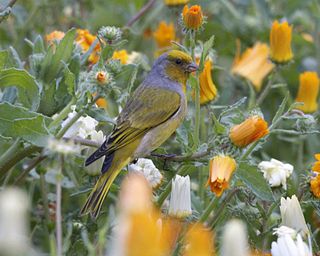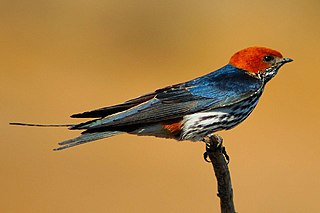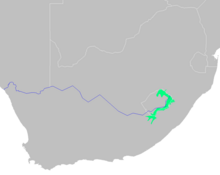
The pine siskin is a North American bird in the finch family. It is a migratory bird with an extremely sporadic winter range.

The pin-tailed whydah is a small songbird with a conspicuous pennant-like tail in breeding males. It is a resident breeding bird in most of Africa south of the Sahara Desert.

The yellow-fronted canary is a small passerine bird in the finch family. It is sometimes known in aviculture as the green singing finch or the ‘’’green singer’’’.

Lawrence's goldfinch is a small songbird of erratic distribution that breeds in California and Baja California and winters in the southwestern United States and northern Mexico.

The Cape canary is a small passerine bird in the finch family. It is a resident breeder in southern Africa and has been introduced to Mauritius and Réunion.

The yellow canary is a small passerine bird in the true finch family. It is a resident breeder in much of the western and central regions of southern Africa and has been introduced to Ascension and St Helena islands.

The streaky-headed seedeater or streaky-headed canary is a small passerine bird in the finch family. It is an unobtrusive but widespread species in suitable habitats of southern Africa. Its presence in an area is revealed foremost by its callnotes.

The lesser striped swallow is a large swallow. It breeds in Sub-Saharan Africa from Sierra Leone and southern Sudan south into eastern South Africa. It is partially migratory with South African birds wintering further north. West African birds leave the north of the breeding range in the dry season.

The Cape siskin is a small passerine bird in the finch family. It is an endemic resident breeder in the southern Cape Province of South Africa.

The brimstone canary or bully canary is a small passerine bird in the finch family. It is a resident breeder in central and southern Africa.

The protea canary, also known as the protea seedeater, white-winged seedeater or Layard's seedeater, is a small passerine bird in the finch family.

The Drakensberg prinia or saffron-breasted prinia is a small passerine bird. It lives in eastern South Africa and Eswatini.

The olivaceous siskin is a species of finch in the family Fringillidae. It is found in Bolivia, Ecuador, and Peru, where its natural habitats are subtropical or tropical moist montane forests and heavily degraded former forest.

The white-throated canary is a species of finch in the family Fringillidae.

The forest canary is a species of finch in the family Fringillidae. It is found in South Africa and Eswatini. Its natural habitats are subtropical or tropical moist lowland forest and subtropical or tropical moist montane forest.

The Tibetan serin or Tibetan siskin is a true finch species.

The cuckoo-finch, also known as the parasitic weaver or cuckoo weaver, is a small passerine bird now placed in the family Viduidae with the indigobirds and whydahs. It occurs in grassland in Africa south of the Sahara. The male is mainly yellow and green while the female is buff with dark streaks. They lay their eggs in the nests of other birds.

Brazza's martin is a passerine bird in the swallow family, Hirundinidae. It is 12 centimeters (4.7 in) long with grey-brown upperparts, heavily black-streaked white underparts, and a brownish tint to the breast plumage. The sexes are similar, but juvenile birds have more diffuse breast streaking and reddish-brown edges to the feathers of the back and wings. The song consists of a series of short notes of increasing frequency, followed by a complex buzz that is sometimes completed by a number of clicks.





















